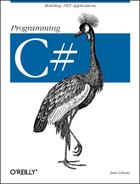All
C# classes, of any type, are treated as if
they ultimately derive from System.Object.
Interestingly, this includes value types!
A base class is the immediate “parent” of a derived
class. A derived class can be the base to further derived classes,
creating an inheritance “tree” or hierarchy. A root class
is the topmost class in an inheritance hierarchy. In C#, the root
class is Object. The nomenclature is a bit
confusing until you imagine an upside-down tree, with the root on top
and the derived classes below. Thus, the base class is considered to
be “above” the derived class.
Object provides a number of methods that
subclasses can and do override. These include Equals( )
to determine if two objects are the same, GetType( ), which returns the type of the object (discussed in Chapter 18), and ToString( ), which
returns a string to represent the current object (discussed in Chapter 10). Table 5-1 summarizes the
methods of Object.
Table 5-1. The methods of Object
|
Method |
What It Does |
|---|---|
|
|
Evaluates whether two objects are equivalent. |
|
Allows objects to provide their own hash function for use in collections (see Chapter 9). | |
|
Provides access to the type object (see Chapter 18). | |
|
|
Provides a string representation of the object. |
|
Cleans up nonmemory resources (see Chapter 4). | |
|
Creates copies of the object; should never be implemented by your type. |
Example 5-4 illustrates the use of the
ToString( )
method inherited from
Object, as well as the fact that primitive
datatypes such as int can be treated as if they
inherit from Object.
Example 5-4. Inheriting from Object
using System;
public class SomeClass
{
public SomeClass(int val)
{
value = val;
}
public virtual string ToString( )
{
return value.ToString( );
}
private int value;
}
public class Tester
{
static void Main( )
{
int i = 5;
Console.WriteLine("The value of i is: {0}", i.ToString( ));
SomeClass s = new SomeClass(7);
Console.WriteLine("The value of s is {0}", s.ToString( ));
}
}
Output:
The value of i is: 5
The value of s is 7The documentation for Object.ToString( ) reveals
its signature:
public virtual string ToString( );
It is a public virtual method which returns a string and which takes
no parameters. All the built-in types, such as
int, derive from Object and so
can invoke Object’s methods.
Example 5-4 overrides the virtual function for
SomeClass, which is the usual case, so that the
class’ ToString( ) method will return a
meaningful value. If you comment out the overridden function, the
base method will be invoked, which will change the output to:
The value of s is SomeClass
Thus, the default behavior is to return a string with the name of the class itself.
Classes do not need to explicitly declare that they derive from
Object; the inheritance is implicit.
